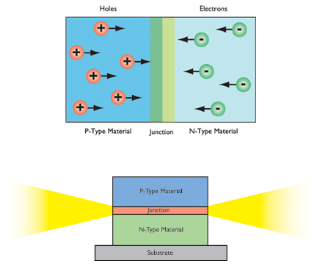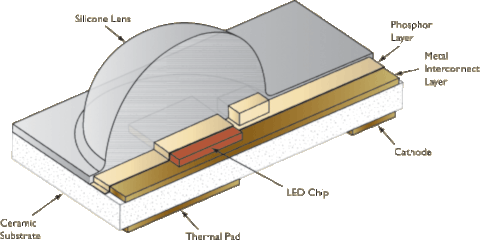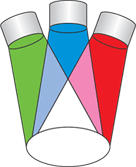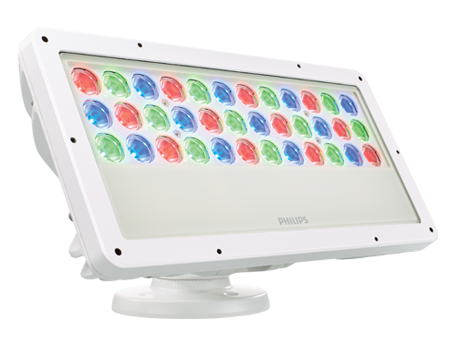Reflect
Stephen P. Clark Government Center
Miami, Florida, USA
Reflect
Stephen P. Clark Government Center
Miami, Florida, USA
Because LED lighting solutions are highly efficient, long lasting, environmentally friendly and inherently controllable — enabling amazingly creative lighting implementations around the world. That's why lighting professionals are using our LED luminaires for a wide range of interior and exterior applications — leveraging the remarkable flexibility of LED technology to explore new opportunities and achieve their creative visions.
When we take a look at the underlying technology that enables LED lighting, we see why it's so long-lasting, reliable, and flexible. An LED has a simple and strong structure. The beauty of this structure is that it's designed to be versatile, allowing for assembly into many different shapes. The light-emitting semiconductor material determines the LED's color, so the number of colors is infinite.
As indicated by its full name — Light Emitting Diode — an LED is a diode that emits light. A diode is a device that allows current to flow in only one direction. Almost any two conductive materials will form a diode when placed in contact with each other — with a single p-n semiconductor junction between them. To create an LED, the n-type material is negatively charged, while the p-type material is positively charged. The atoms in the n-type material have extra electrons, while the atoms in the p-type material have electron holes — electrons missing from their outer rings.
Applying electrical current to the diode pushes the atoms in both materials toward the junction area. When they get close to each other, the n-type atoms donate their extra electrons to the p-type atoms, which accept them. When extra electrons in the n-type material fall into the holes in the p-type material, they release energy in the form of photons — the basic units of electromagnetic radiation.
All diodes release photons, but not all diodes emit light — just light-emitting diodes. The material in an LED is selected so that the wavelength of the released photons falls within the visible portion of the light spectrum. Different materials produce photons at different wavelengths, which appear as light of different colors.


Illuminator type LED
LEDs produce different colors by using various materials which produce photons at different wavelengths. Those individual wavelengths appear as light of different colors.
LEDs use materials that can handle the necessary levels of electricity, heat, and humidity. High-brightness red and amber LEDs use the aluminum indium gallium phosphide (AlInGaP) material system. Blue, green and cyan LEDs use the indium gallium nitride (InGaN) system.
Together, AlInGaP and InGaN cover almost the entire light spectrum, with a gap at green-yellow and yellow. One method of achieving a larger spectrum of colors is to mix different colors of LEDs in the same device.
Combining red, green, and blue LEDs in a single LED device, such as a lighting fixture or multi-chip LED, and controlling their relative intensities can produce millions of colors. Additionally combining red, green, and blue in equal amounts produces white light.

To be used for illumination, LEDs must be integrated into luminaires that incorporate optics, LED drivers, power supplies, and thermal management. Well-designed LED luminaires integrate all of these critical components into the luminaire itself.

LEDs offer a variety of advantages to lighting professionals and ultimate beneficiaries of LED lighting systems — from creative individuals to innovative businesses to visionary cities and countries:
What do all these advantages mean?
Over the past decade, LED technology has advanced rapidly as demand grew and innovation improved manufacturing methods and LED-related technologies. The once-humble LED (used for indicator lights and other lowly applications) is now the preferred light source for high-profile and large-scale lighting projects. And today's lighting professionals are exploring a remarkable new frontier opened up by LED lighting — and Color Kinetics.
Visit the LED Lighting Showcase to see hundreds of other installations, from small to complex, that all benefit from the many advantages of LED lighting.
From tunable white to dynamic color, Color Kinetics LED luminaires now illuminate the world’s most iconic buildings, bridges, and other landmarks – as well as retail shops, television studios, theater and concert stages, hotels, casinos, hospitals, restaurants, celebrity-filled nightclubs, and much more. And we provide all the related solutions and technologies that enable and optimize innovative LED lighting – from thermal management, binning, optics, and color consistency to high-efficiency LED drivers and advanced power components.